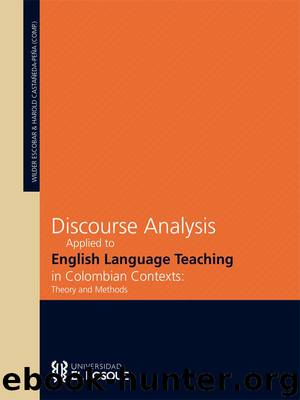Discourse Analysis Applied to English Language Teaching in Colombian Contexts by WILDER ESCOBAR HAROLD CASTAÑEDA-PEÑA

Author:WILDER ESCOBAR, HAROLD CASTAÑEDA-PEÑA
Language: eng
Format: epub
ISBN: 9789587390629
Publisher: UNIVERSIDAD EL BOSQUE
Published: 2018-02-03T00:00:00+00:00
Implications of the Three Research Works
After having presented the results of my three research works, it is notable that language classroom interaction is composed of varied interaction patterns that the teacher and the learners create, co-construct, and then maintain, all in line with the particular interactional context and the established conventions of the class. The teacher and the learners institute such contexts and conventions as they progress in their interactions. In consequence, language classroom interaction is full of co-constructed interaction patterns that depend not only on learner and teacher’s factors (Johnson, 1995; Cameron, 2001b; Seedhouse, 2004a; and Kurhila, 2006) but also on the particular interactional contexts and the established conventions of the class. The cited authors point that the factors that allow the presence of determined interaction patterns are, on one side, learner’s age, L2 proficiency level, roles, and motivation, and on the other side, teacher’s agenda, assumed roles, lesson plans, materials, and management.
The three research works presented in this chapter contribute to the findings of language classroom interaction by exposing that the interaction patterns that may emerge in a language classroom not only depend on the stated factors but also on the interactional contexts and the conventions of the class. Both the teacher and the learners institute the interactional context by progressively determining the sequence and function of their talk-in-interaction in similar class activities (how to interact in certain moments of the class activities, e.g., by waiting for teacher’s nomination, answering teacher’s questions, receiving feedback or evaluation, adding content, asking for clarification, confirmation, or content). Equally, both the teacher and the learners institute the established conventions of the class by indicating, throughout the class activities, what is permitted to do in the talk-in-interaction (e.g., L1 use, accurate L2 speaking, short answers or contributions, immediate corrections, incorporation of feedback, evaluation, or lexical-item provision).
In the results of the three research works, it is visible how the interactional context and the established conventions of the class cause the emergence of particular interaction patterns to happen. For instance, more presence of L1 lexicon in L2 talk may reside on premature demands to produce well-constructed L2 talk, which holds an institutional belief of making the learners use accurately and fluently the L2 since the very first classes and proficiency levels. Another example is the repetition of the interaction pattern of asking about content, in which the learners ask the teacher for further explanation or clarification about the content of a linguistic exercise. The teacher and the learners established it according to the convention of learners’ asking for unclear content at any time throughout the class activity. Similarly, it happens to the pattern of adding content in which the learners know that the space the teacher opens is only for their contributions. Alternatively, the RPA sequence seems to be maintained in varied contexts when English language learners request their teachers for the provision of the L2 equivalent of an L1 lexical item, expectation that the teacher feels the necessity to fulfill with the accuracy to fit into the learner’s current idea.
Download
This site does not store any files on its server. We only index and link to content provided by other sites. Please contact the content providers to delete copyright contents if any and email us, we'll remove relevant links or contents immediately.
Spare by Prince Harry The Duke of Sussex(5140)
Navigation and Map Reading by K Andrew(5133)
Tuesdays with Morrie by Mitch Albom(4732)
Machine Learning at Scale with H2O by Gregory Keys | David Whiting(4259)
Cracking the GRE Premium Edition with 6 Practice Tests, 2015 (Graduate School Test Preparation) by Princeton Review(4248)
Never by Ken Follett(3884)
Goodbye Paradise(3761)
What It Really Takes to Get Into Ivy League and Other Highly Selective Colleges by Hughes Chuck(3716)
Harry Potter and the Prisoner of Azkaban (Book 3) by J. K. Rowling(3324)
Fairy Tale by Stephen King(3307)
Pledged by Alexandra Robbins(3152)
Kick Ass in College: Highest Rated "How to Study in College" Book | 77 Ninja Study Skills Tips and Career Strategies | Motivational for College Students: A Guerrilla Guide to College Success by Fox Gunnar(3100)
A Dictionary of Sociology by Unknown(3044)
Sapiens and Homo Deus by Yuval Noah Harari(3029)
Reminders of Him: A Novel by Colleen Hoover(3011)
The Social Psychology of Inequality by Unknown(2987)
Graduate Admissions Essays, Fourth Edition: Write Your Way into the Graduate School of Your Choice (Graduate Admissions Essays: Write Your Way Into the) by Asher Donald(2890)
Will by Will Smith(2872)
Zero to Make by David Lang(2753)
